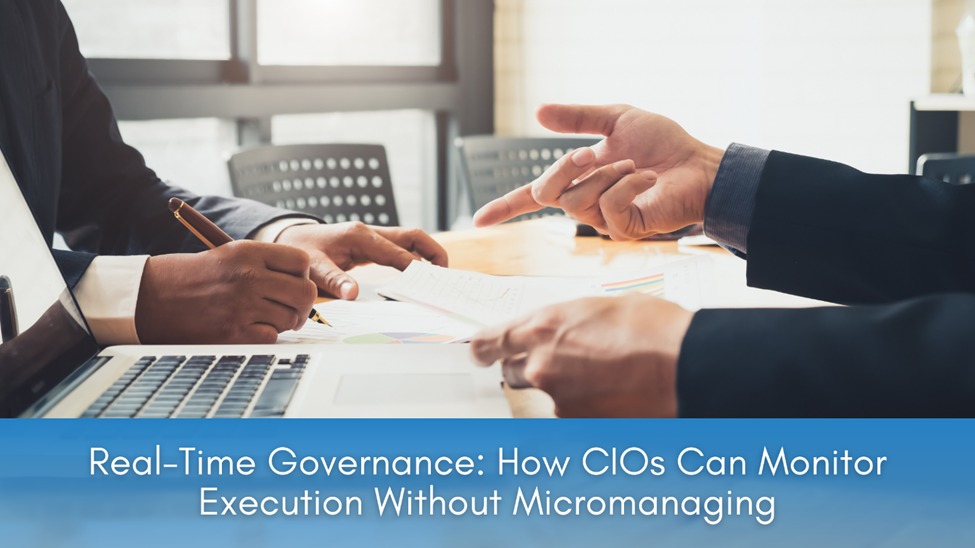
Introduction – The CIO’s Dilemma
In today’s fast-paced digital enterprise, CIOs are under relentless pressure to deliver initiatives on time, within budget, and aligned with strategic goals. The challenge? Maintaining clear visibility into execution without falling into the trap of micromanagement a habit that stifles innovation, erodes trust, and drains productivity.
Real-time governance offers a way forward. By leveraging technology, structured processes, and actionable insights, CIOs can monitor progress, detect risks early, and enable teams to deliver without the need to constantly hover over every task.
Why Real-Time Governance Matters More Than Ever
The Speed of Business Has Changed
Business cycles are shorter, markets shift faster, and customer expectations evolve daily. In this environment:
- Delays mean lost market opportunities.
- Misalignment between strategy and execution can derail an entire transformation program.
- Decision-making must be data-driven and immediate.
The Risks of a Traditional Governance Model
Traditional governance often means monthly status reviews, manual updates, and after-the-fact reporting. This model creates:
- Blind spots between reporting cycles.
- Slow risk detection that escalates into crises.
- Reactive decision-making instead of proactive interventions.
Defining Real-Time Governance for CIOs
What It Is and What It’s Not
Real-time governance is continuous oversight of execution health through live data, dashboards, and automated alerts. It’s not about chasing every update or overriding team autonomy.
Key characteristics:
- Always-on visibility into project KPIs.
- Risk detection in minutes, not weeks.
- Execution alignment with strategic objectives.
The Balance Between Control and Autonomy
CIOs must strike a balance:
- Too much control = micromanagement, demotivated teams.
- Too little oversight = missed risks, delivery failures.
Real-time governance delivers just enough control to ensure accountability while empowering teams.
The CIO’s Toolkit for Real-Time Governance
Integrated Execution Platforms
Solutions like Initiatives.app embed governance into the same environment where teams collaborate (e.g., Microsoft Teams). This reduces the friction of “platform hopping” and ensures updates are naturally captured in real time.
Key benefits:
- Unified view of all initiatives.
- Automatic update capture.
- Seamless integration with workflows.
Real-Time Dashboards & KPIs
Dashboards should provide:
- Execution status by initiative, portfolio, and strategic goal.
- Early warning signals for risks.
- Drill-down capabilities for detailed views.
Example internal link: See how Whizible enables a single version of truth for execution.
Automated Alerts and Escalations
Rather than reviewing every detail daily, CIOs can rely on automated rules:
- Notify when a milestone slips.
- Escalate if risk probability crosses a threshold.
- Highlight overdue tasks or budget overruns.
Framework for Implementing Real-Time Governance Without Micromanaging
Step 1 - Define Key Governance Metrics
Avoid tracking every metric under the sun. Focus on:
- Delivery predictability.
- Budget adherence.
- Strategic alignment.
- Risk levels.
Step 2 - Embed Governance in the Flow of Work
Instead of demanding separate status reports, capture progress as work happens. This is where an integrated platform like Initiatives.app in Microsoft Teams excels.
Step 3 - Automate Data Collection
Remove manual reporting overhead by integrating with tools teams already use Jira, Trello, Teams, SharePoint.
Step 4 - Set Smart Thresholds for Intervention
Define clear parameters for when CIO intervention is needed preventing unnecessary involvement in every minor issue.
Benefits of Real-Time Governance
For CIOs
- Proactive risk management: Address issues before they snowball.
- Data-driven decisions: Rely on facts, not opinions.
- Increased bandwidth: Focus on strategic leadership rather than operational firefighting.
For Teams
- Less reporting fatigue: No need for redundant manual updates.
- Greater trust: Autonomy to execute within agreed boundaries.
- Faster decisions: Issues resolved in real time.
Overcoming the Pitfalls
Avoid Information Overload
Too much data can be as dangerous as too little. Curate dashboards to show what matters most to governance.
Guard Against “Invisible Micromanagement”
Real-time tools can tempt leaders to constantly check in. Set boundaries use data to guide conversations, not to dictate every move.
Case Study - Real-Time Governance in Action
Scenario: A CIO overseeing a global digital transformation with 15 concurrent initiatives.
Challenge: Status visibility lagged by two weeks, delaying risk response.
Solution: Implemented Initiatives.app within Microsoft Teams for real-time status updates, automated alerts, and centralized dashboards.
Result:
- Risk detection improved by 60%.
- Meeting time for governance reviews reduced by 40%.
- Employee engagement scores increased due to reduced micromanagement.
Future of Real-Time Governance
- AI-driven insights: Predict risks before they emerge.
- Cross-enterprise visibility: Governance beyond IT into all strategic initiatives.
- Adaptive governance models: Governance that evolves with business priorities.
Conclusion - Governance Without the Grip
Real-time governance empowers CIOs to be strategic enablers, not tactical controllers.
By embedding oversight into the flow of work, automating updates, and focusing on critical metrics, CIOs can ensure projects deliver value without suffocating teams.
👉 Book a personalized demo now : https://calendly.com/vishw/30min/invitees
📥 Learn more about features, benefits, and use cases at:
👉 www.initiatives.app
Contact Us : info@whizible.com | +91 855-498-3315
Address : Mrugank, Level 3, Kothrud, Pune, Maharashtra, 411038